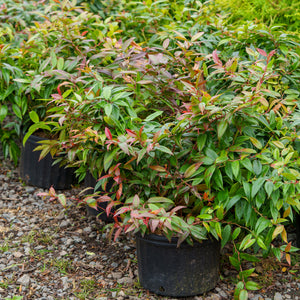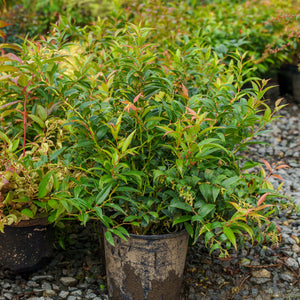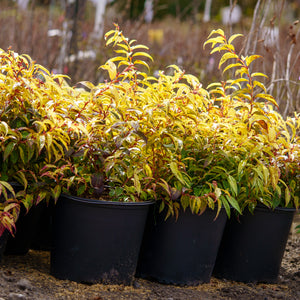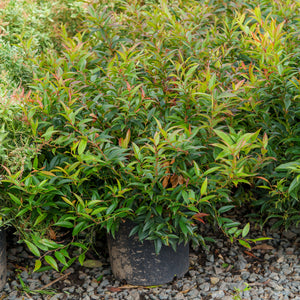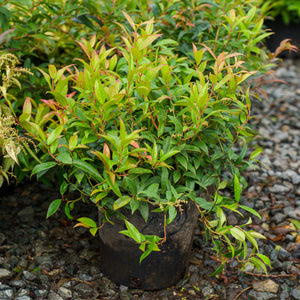The Leucothoe Guide
Leucothoe is a genus of shade-loving, evergreen shrubs prized for their graceful arching form, glossy foliage, and multi-season interest. Valued for their tolerance of damp and acidic soils, Leucothoe shrubs are an excellent choice for woodland gardens, shady slopes, and beneath larger trees. Many varieties feature deep green, bronze, or variegated leaves that shift color through the seasons, while spring brings small, bell-shaped white flowers reminiscent of pieris or andromeda.
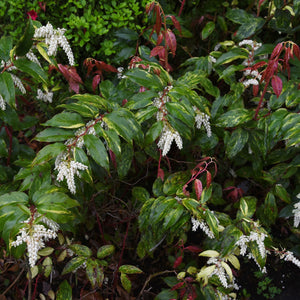
About
Leucothoe belongs to the heath family (Ericaceae), closely related to plants like rhododendron, pieris, and blueberry. These broadleaf evergreen shrubs are native to the southeastern United States and parts of Asia, where they thrive in moist understories and along streambanks.
The most commonly grown species include:
- Leucothoe axillaris – Native to the southeastern U.S., this species is compact and dense with arching stems and leathery green leaves. Popular cultivars include ‘Jenkins’, ‘Rejoyce’, ‘Burning Love’, and ‘Little Flames’, all valued for foliage color and tight growth habits.
- Leucothoe fontanesiana – Also known as dog hobble, this species tends to grow taller and wider, with slightly longer leaves and a more open form. Notable selections like ‘Rainbow’, ‘Scarletta’, and ‘Rollisonii’ provide vibrant foliage tones and excellent shade coverage.
- Leucothoe keiskei – Native to Asia, this species is often more cold-hardy and features fine-textured foliage with a graceful shape. Cultivars like ‘Burning Love’ and ‘Halloween’ offer year-round color shifts and compact size for refined garden use.
Leucothoe is often used where few other shrubs thrive—under trees, along streams, or on north-facing slopes. Their year-round foliage color, paired with spring blooms and wildlife value, makes them a valuable addition to naturalistic and designed landscapes alike.
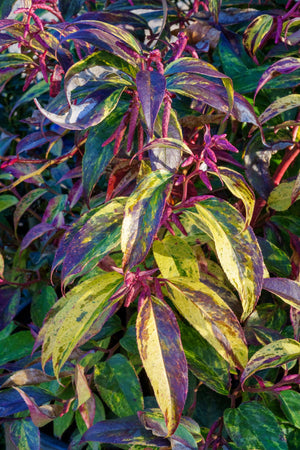
PLANTING
Leucothoe thrives in environments that mimic its woodland origins, preferring filtered light, consistent moisture, and rich organic soil.
USDA Hardiness Zones: Most varieties grow well in Zones 5–8. Leucothoe axillaris may struggle in colder regions, while Leucothoe keiskei and Leucothoe fontanesiana offer greater cold tolerance.
Soil: Moist, well-drained, acidic soil enriched with organic matter is ideal. Avoid alkaline or compacted soils, which can cause chlorosis or leaf drop.
Sunlight: Dappled shade to full shade is preferred. Some cultivars like ‘Rainbow’ and ‘Little Flames’ can tolerate part sun, especially in cooler climates. Too much sun may bleach or scorch the foliage.
Watering: Regular watering is essential, especially during dry spells or the first two growing seasons. Leucothoe prefers consistently moist—not soggy—conditions.
Spacing: Space plants 2 to 4 feet apart depending on variety. Leucothoe axillaris cultivars are typically compact, while Leucothoe fontanesiana selections can spread 4 to 6 feet wide at maturity.
Planting Time: Spring or early fall is ideal. Avoid planting during hot, dry weather unless irrigation is available.
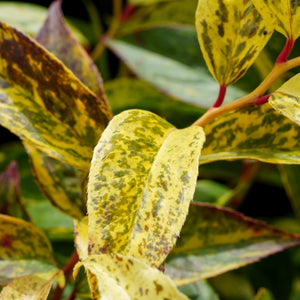
CARE
Watering: Water regularly, particularly during dry spells or in sandy soils. Leucothoe prefers moist environments and may suffer if allowed to dry out completely.
Fertilizing: Fertilize lightly in early spring with an acid-loving plant fertilizer. Avoid excessive nitrogen, which can reduce color vibrancy and lead to overly soft growth.
Pruning: Pruning is rarely needed beyond shaping. If desired, prune immediately after flowering in late spring. Remove any dead, damaged, or crossing branches and trim back leggy stems to encourage denser growth. For rejuvenation, older plants can be cut back hard in early spring before new growth begins.
Pests and Diseases: Pests and diseases are rare but can include leaf spot or black spot, especially in humid or shaded environments with poor air circulation. Improve airflow by thinning dense branches and avoid overhead watering. If symptoms persist, treat with a fungicide labeled for broadleaf evergreens and remove affected foliage.
Mulching: Mulch helps conserve soil moisture and maintain even temperatures. Apply 2–3 inches of mulch around the base, keeping it several inches away from the crown.
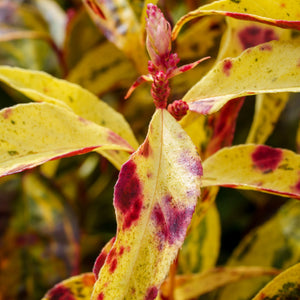
HOW TO USE
Focal Point: Bold-leaved cultivars like Leucothoe fontanesiana ‘Rainbow’ or the richly colored Leucothoe axillaris ‘Burning Love’ make excellent focal points in shaded borders, under trees, or in small courtyard beds. Their shifting seasonal tones and arching form provide visual contrast against evergreen backdrops or stone features.
Woodland Gardens: Leucothoe is well-suited for use in woodland or naturalized gardens where it mimics its native habitat. Plant in drifts under deciduous or coniferous trees and pair with native companions like ferns and foamflower to create a layered, ecological planting.
Mixed Borders: In shrub or perennial borders, Leucothoe blends well with shade-tolerant species like hosta, astilbe, and brunnera. The arching shape and colorful leaves add year-round structure and soften the edges of beds or pathways.
Foundation Plantings: Compact cultivars like ‘Squirt’ and ‘Jenkins’ are ideal for low foundation plantings, particularly on the north or east side of buildings. Their evergreen foliage offers winter interest and year-round coverage while remaining easy to maintain.
Japanese or Shade Gardens: In Asian-inspired or minimalist gardens, Leucothoe’s arching form and fine foliage contrast beautifully with moss, stone lanterns, or ornamental grasses. Use it to bridge pathways or soften structural elements.
Containers: Smaller cultivars thrive in shaded containers on patios or shaded porches. Pair Leucothoe with coral bells, ivy, or dwarf ferns for a lush, layered container display that offers color in all seasons.
Erosion Control: On slopes or shaded banks, Leucothoe’s dense root system helps stabilize soil while providing attractive coverage. Mass plantings of spreading varieties such as Leucothoe fontanesiana ‘Rollisonii’ can create natural, low-maintenance ground layers.
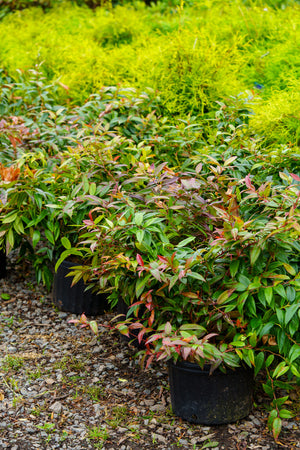
Common Questions
How to prune Leucothoe? Prune immediately after flowering in late spring. Remove damaged or crossing stems and shape the plant as needed. Older shrubs can be cut back hard in early spring to rejuvenate them.
Is Leucothoe deer resistant? Yes, Leucothoe is generally considered deer resistant, though deer may occasionally browse young plants in areas with heavy pressure.
Is Leucothoe evergreen? Most commonly grown species of Leucothoe are broadleaf evergreens, providing color and structure year-round.
Is Leucothoe poisonous to dogs or cats? Leucothoe contains grayanotoxins, which can be toxic to pets if ingested. Keep pets away from chewing the leaves or stems.
Do rabbits eat Leucothoe? Leucothoe is typically avoided by rabbits due to its leathery foliage and chemical composition, making it a good choice in rabbit-prone areas.
When to prune Leucothoe? Prune just after spring flowering for shaping or rejuvenation. Avoid late-season pruning, which can disrupt the plant's seasonal cycle.
Do some Leucothoe do better in sun? Yes, some cultivars such as ‘Rainbow’ and ‘Little Flames’ tolerate more sun, especially in cooler regions, but most perform best in dappled shade.
How large do Leucothoe grow? Depending on the species and cultivar, Leucothoe may range from 2 to 6 feet tall and wide. Compact cultivars stay small, while spreading types can cover larger areas.
How to plant Leucothoe? Plant in rich, well-drained acidic soil in a shaded or partially shaded spot. Dig a hole twice as wide as the root ball and water deeply after planting.
How to propagate Leucothoe? Leucothoe can be propagated by semi-hardwood cuttings in late summer or by layering low branches in spring.
How to treat black spot on Leucothoe? Improve air circulation, remove affected leaves, and avoid overhead watering. Use a fungicide if needed for persistent infections.
Conclusion
Leucothoe is a dependable and visually captivating evergreen shrub that brings structure, color, and versatility to shaded gardens. From colorful cultivars to tough native forms, Leucothoe adapts to a variety of landscape needs—from erosion control and foundation planting to focal point specimens in shady beds. With minimal maintenance and strong aesthetic value across seasons, Leucothoe is a smart and stylish addition to any woodland or part-shade design.
The Leucothoe Collection
Sold Out
Sold Out

